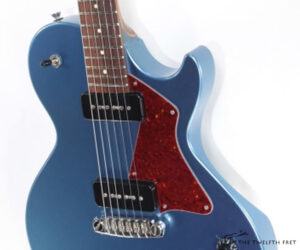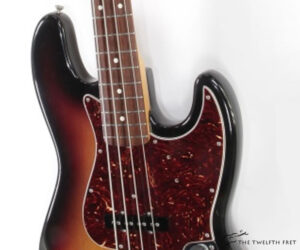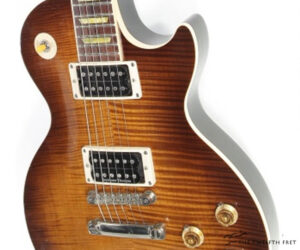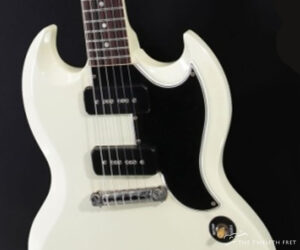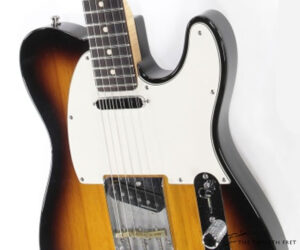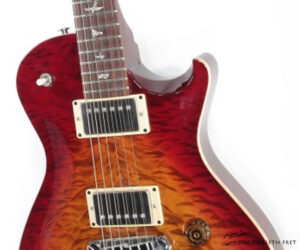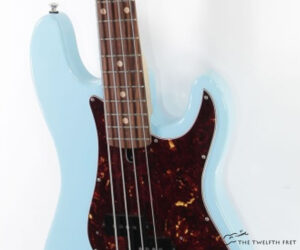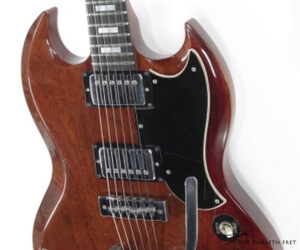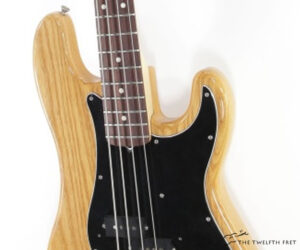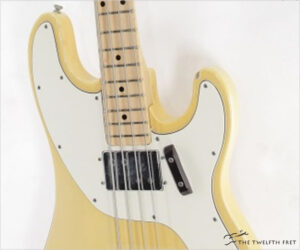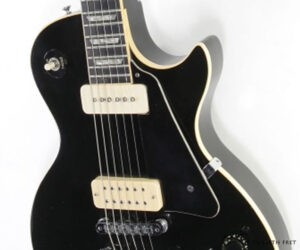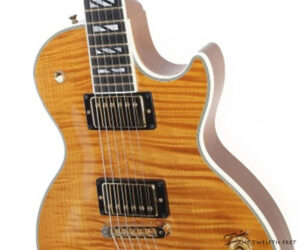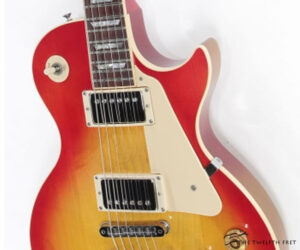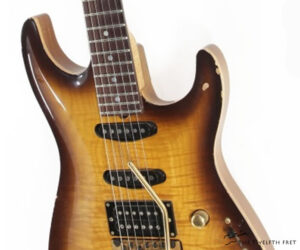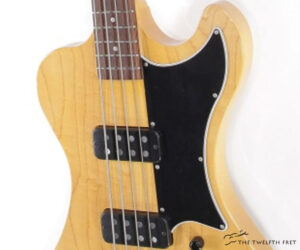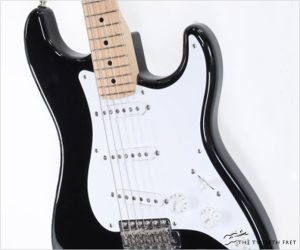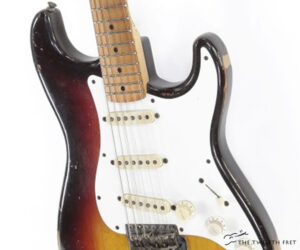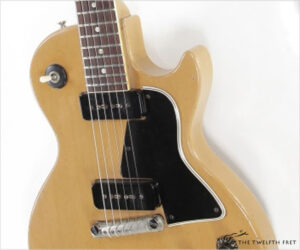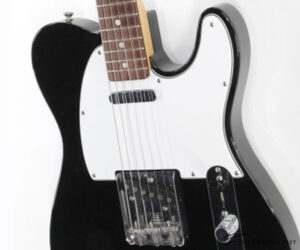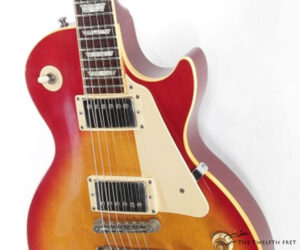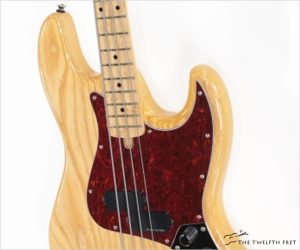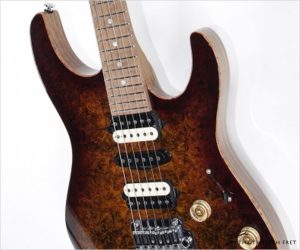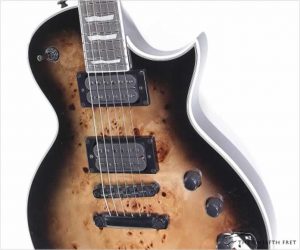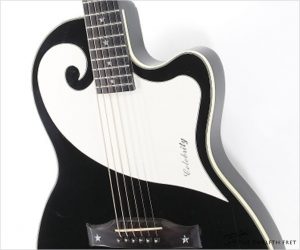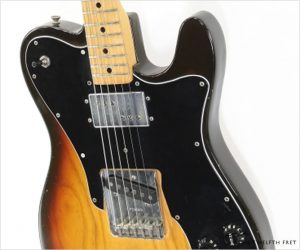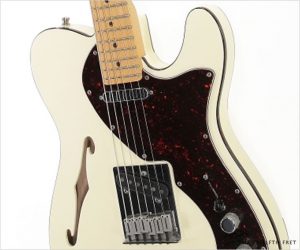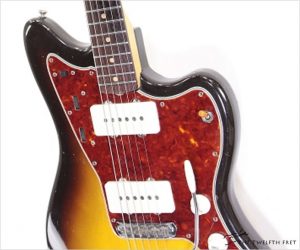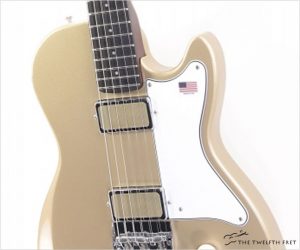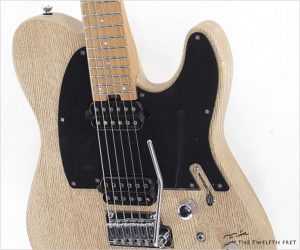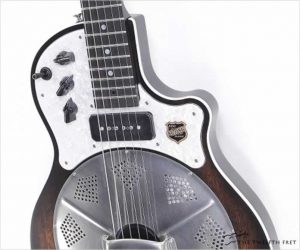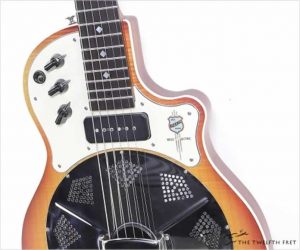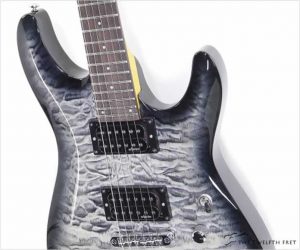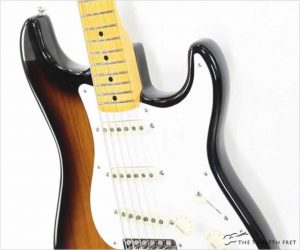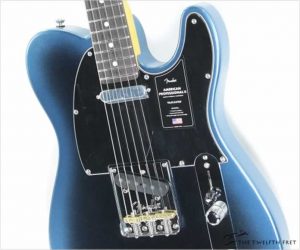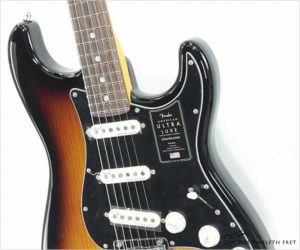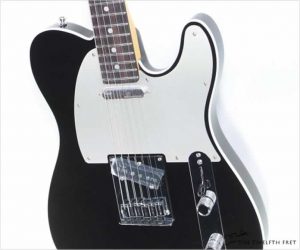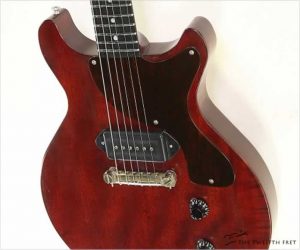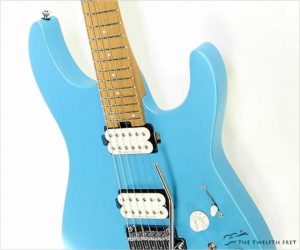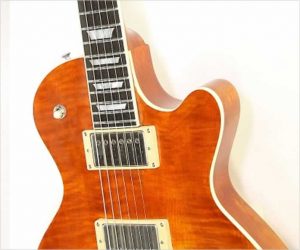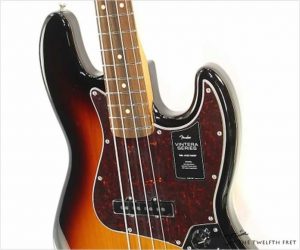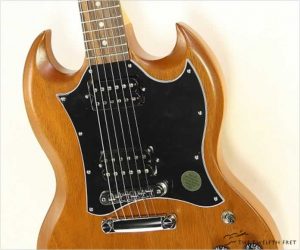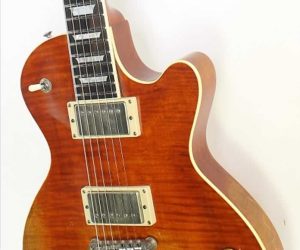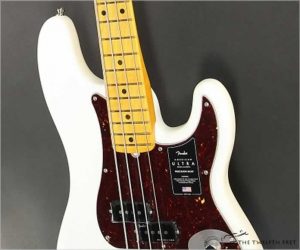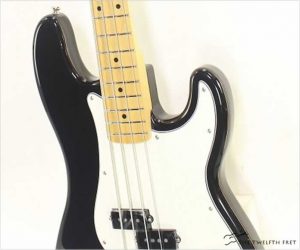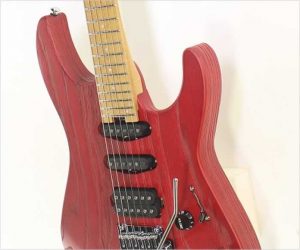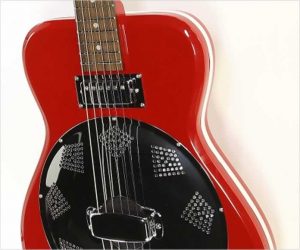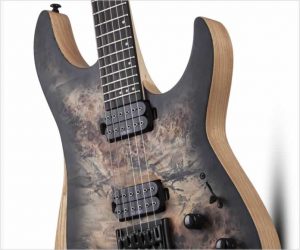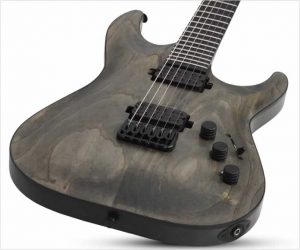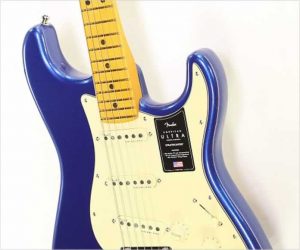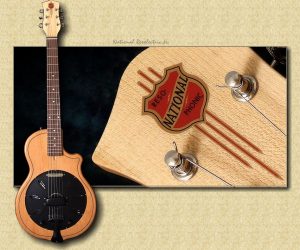While the source of the name given to this Collings 290 may seem obvious as it’s got two P90 pickups, it’s really a reference to the road outside the Collings shop. Drawing from a few traditional solidbody models, the 290 was launched in 2006 at the NAMM show, and has been in production since. Built during 2018 in Austin Texas, this Pelham Blue Collings 290 has some differences from current production.
Solidbody
The Fender American Vintage ’62 Jazz Bass was built from 1999 to 2002. As part of the American Vintage series, this bass reprises the early specifications of the highly influential successor to the revolutionary Precision bass.
The Gibson Les Paul Classic Premium Plus was built from 1993 to 2001 as a high end version of the Classic, which provided the slimmer 1960 neck profile. As with other higher end Les Paul models, the body features a Mahogany back with a highly figured, bookmatched Flame Maple cap, Mahogany body and Indian Rosewood fingerboard.
The 2007 Gibson SG Special VOS replicates the 1961 style, with a pair of P90 pickups and Classic White finish. Currently this model is offered as the 1963 SG Special Classic White Ultra Light Aged. Like the SG itself, the SG Special originated as a Les Paul model, officially renamed in late 1963 at the end of Les Paul’s endorsement contract
From 2006 at the Custom Shop, this Fender Custom American Telecaster sports a sunburst finish and a Glendale bridge plate and saddle set. The Fender Custom American Telecaster starts with a rather full, large ‘C’ profile, AAA grade birdseye Maple neck with an Indian Rosewood fingerboard, paired with a lightweight Ash body.
This PRS SC-245 10 Top in dark cherry sunburst is a thing of beauty, in very good clean and original condition. The SC-245 model has been in and out of production twice, from 2007 to 2009 and then 2013 to 2016.
Here we’re looking at a first-year PRS SC-245 10 Top, built during 2007 in Stevensville, Maryland. Based on the Singlecut body design, this guitar has a spectacular, highly figured bookmatched Quilted Maple top on a Mahogany back.
Shown here is a Lakland USA Bob Glaub 44-64 Bass with Rosewood fingerboard and Sonic Blue finish, built during 2017 in Chicago, Illinois. Bob Glaub is a highly experienced American bassist who has long worked with Jackson Browne and many other top rank artists.
Shown here is an original condition Gibson SG Standard with optional Bigsby from 1973, in Walnut finish and originally sold at Mamelok LTD in Manchester, England, which closed in 1993. The Gibson SG Standard launched with the SG name in 1963, but really first appeared in 1961 as a radical redesign of the Les Paul model.
Introduced in 1951 and still in production with relatively minor changes, the Fender Precision Bass is an example of a designer getting almost everything right. Immediately, it almost completely displacing the upright bass it was intended to challenge, and it has become one of the most-used and most-recorded instruments in history.
While the source of the name given to this Collings 290 may seem obvious as it’s got two P90 pickups, it’s really a reference to the road outside the Collings shop. Drawing from a few traditional solidbody models, the 290 was launched in 2006 at the NAMM show, and has been in production since. Built during 2018 in Austin Texas, this Pelham Blue Collings 290 has some differences from current production.
The Fender Telecaster Bass launched in the surprisingly late year of 1968, though its appearance is very much like the original, revolutionary 1951 Precision Bass. From a modern perspective, there isn’t a lot to the Fender Telecaster Bass.
The Gibson Les Paul Pro Deluxe was built from 1978 to 1982 and blended features of several previous Les Paul models. Based on the Les Paul Deluxe, the Pro Deluxe had P-90’s in place of mini-humbuckers, a Maple neck and Ebony fingerboard with trapezoidal position markers.
Introduced in 2003 and built at the Nashville Tennessee shop, the Gibson Les Paul Supreme is a high-end take on the classic design and features carved, highly figured Maple top and back. The construction of the Gibson Les Paul Supreme differs from the standard Les Paul though it uses the same basic materials as the Les Paul Custom. The carved top and back set are bookmatched, highly flamed Maple, on either side of a chambered Mahogany core
Here’s a Gibson Les Paul Standard Cherry Sunburst dating to October 22, 1980, sporting a Cherry Sunburst finish and a non-weight relieved, non-pancake body! The Les Paul model was introduced in 1952 as Gibson’s entry into the then-new solidbody ‘Spanish’ electric guitar field, where ‘Spanish’ refers to the way the guitar is held.
Shown here is a Pensa Custom MK-1 built during 1995 in New York City by Rudy Pensa. The MK designation stands for Mark Knopfler. The original MK model was designed by Pensa and Knopfler to create a guitar capable of sounding like the 1961 Strat and 1958 Les Paul Knopfler was using on stage, allowing him to use only one guitar.
The Gibson RD Artist Bass were built during 2018, revisiting the original RD Basses from 1977 to 1981. These distinctive basses draw from Gibson’s original Firebird and Thunderbird designs, but are definitely not copies. The early RD Bass line consisted of two models, the Standard, and Artist. Construction was Maple for the body and Laminated Maple for the neck, with a Maple fingerboard.
Here is a Fender ‘Blackie’ Eric Clapton Signature Stratocaster which was built during 2008 and is in great original condition. This model, introduced in 2004 and built by a team (as distinct from one master builder) features an Alder body and soft-V 22-fret, 9.5 inch radius Maple neck, with a Custom Shop logo and Clapton signature above ‘Blackie’ on the back of the head.
Showing distinct signs of having been used as intended, this Fender Stratocaster Sunburst was built during 1958 in Fullerton, California. Introduced in 1954 as the successor to the Telecaster, work on the Fender Stratocaster began in 1951.
The Gibson Les Paul Special TV model appeared in 1955, with the ‘TV’ referring to a special ‘limed’ finish intended to make the guitar more visible on black and white televisions and films. This finish had become available in 1954 on the Les Paul TV, a single-pickup Les Paul Junior. Both models used a slab Mahogany body with no Maple cap, and a Mahogany neck, with a bound Rosewood fingerboard, which into the mid 1960’s meant Brazilian Rosewood.
This Fender 67 Tele Closet Classic sports a period correct Rosewood fingerboard and was built during April 2005 in Corona, California. Built to original 1967 specs pairing an Ash body with an Indian Rosewood Maple neck, this guitar also includes all original style hardware – the Schaller made F-stamped tuners, Ashtray style bridge and custom shop pickups.
Presented here is a splendid 1993 Gibson Les Paul Standard, thoughtfully enhanced with a host of wiring and hardware upgrades. This meticulously preserved instrument retains all of its original components, while introducing noteworthy improvements.
This Overwater Scott Devine Model 4 J Series Bass dates to 21 August 2017, and features a Swamp Ash body paired with a 33 inch scale Birdseye Maple neck. It also includes Overwater’s own active electronics, powered by a single 9v battery.
Here we have a spectacular Suhr Custom Modern Plus with a Burled Maple cap finished in Bengal Burst on an African Black Limba body and Roasted Maple neck. This beautiful, very well built Suhr Custom Modern Plus is in nearly new condition with only the slightest wear. The stainless steel frets show no signs of wear, and the finish is near pristine.
The LTD EC1000 in Black Natural Burst is designed by ESP in Japan and built in Indonesia. This is a well designed and built modern take on the single-cutaway carved top solidbody guitar concept. This model uses Mahogany body with a burled Poplar top, and a ‘Set-Through’ neck joint for the 3-piece Mahogany neck.
The Gibson Chet Atkins Celebrity SST was built from 1991 to 1993 as a version of the CEC – the Chet Atkins Classical, solidbody nylon string guitar.
The 1970’s Fender Telecaster Custom was a significant departure from the 1960’s Custom, which had basically been a stock model with a bound body. In contrast, the Telecaster Custom introduced in 1972 and built until 1979 introduced the head-end “Bullet” truss rod adjuster, the three-bolt MicroTilt neck angle adjuster, and a huge change for Fender – the Wide-Range Humbucker designed by Seth Lover.
The Fender Thinline Telecaster was introduced in 1969 as a design by Roger Rossmeisl, who had done major work for Rickenbacker. There have been a few versions of this model, and this particular 1998 example seems to me one of the best ever.
The Fender Jazzmaster appeared halfway through 1958, targeted at jazz artists, the group Fender hadn’t fully won over. One of the key features of the Fender Jazzmaster was the introduction of a Rosewood fingerboard on the Maple neck. To this point in time, Fender necks had been a single piece of Maple with a rear Walnut ‘Skunk Stripe’ covering the truss rod channel.
This Harmony Jupiter in a cool Champagne nitrocellulose lacquer finish is a retro solidbody guitar built in Kalamazoo, Michigan. The Jupiter marks the return of what was at one time of the world’s largest instrument manufacturers. The Harmony Jupiter’s classic looks and well-rounded tonality make it a perfect match for any style or genre.
The new Charvel SoCal Style 2 has arrived, featuring an Ash T-style body with a licensed reverse-Tele headstock, a pair of Fishman humbuckers, and a 2-point trem! The Charvel SoCal Style 2 Ash body also features a scalloped lower back bout and shredder’s cut heel for easier upper fret access and hours of grin-inducing playing-feel and performance.
Built in San Luis Obispo California, the National Resolectric Revolver blends the resophonic and solidbody electric guitar concepts, to great success. Very similar in design to the ResoLectric, the National Resolectric Revolver uses a solid Mahogany body that’s routed for the resonator and electric pickups, and a bolt-on Mahogany neck with Rosewood fingerboard. The headplate is a faux pearl covering.
Built in San Luis Obispo California, the National Resolectric solidbody guitar Sunburst blends the resophonic and solidbody electric guitar concepts, to great success. Very similar in design to the Resolectric Revolver, the National Resolectric uses the familiar pairing of a flame Maple top on a Mahogany body that’s routed for the resonator and electric pickups, and a bolt-on flame Maple neck with Rosewood fingerboard. The headplate is a faux pearl covering.
The Schecter C6 Plus is a straight ahead, no-nonsense model providing great looks, playability and tone at a reasonable price. Combining the proven ingredients of a Maple neck with 24-fret Indian Rosewood fingerboard and a Basswood body, the Schecter C6 Plus also sports a top ‘image’ layer of Quilted Maple, finished with a very nice Charcoal Burst finish.
The Fender American Professional II Telecaster with Rosewood fingerboard and Dark Night finish features rolled edges on a deep C profile neck, narrow-tall frets, heel contour, V-Mod II single-coil Telecaster pickups, and a stock treble bleed circuit to preserve highs when the volume control is turned down. A new bridge design with three compensated brass saddles can be strung either from the top, or the traditional rear-load.
The Brand new Fender Ultra Luxe Stratocaster has arrived! This is one of the first Fender production models to bear Stainless Steel frets. It also has other helpful features like locking tuners, a push-in trem arm and noiseless pickups with the S-1 switch, giving access to all pickup combinations.
Here is the new Fender American Ultra Telecaster Rosewood Board in seen here in the new Texas Tea finish, with new body contours, stock noiseless pickups, new electronics, biflex truss rod, and a compound radius fingerboard!
Here is an Eastman SB55DC /V Solidbody in Vintage Varnish! This definitely evokes the mid 1950’s slab bodied models, and with top quality hardware. Introduced in mid 2020 and now making its way to us, the Eastman SB55DC /V features a slab body and neck of lightweight Okoume Mahogany, sourced from Gabon, Central Africa. The fingerboard, head plate and truss rod cover are Ebony, and that’s it for woods used.
Charvel guitars have a long standing reputation as the guitar for choice for modern players looking for a fast playing feature laden instrument. The new Charvel ProMod DK 24HH 2PT CM model from the Pro-Mod series boasts a feature set and playability that will rival instruments double the price. The first thing you may notice is the lovely roasted maple neck. In addition to the rich visual aesthetic the process of roasting the maple and taking out moisture makes for a more stable neck that won’t shift as much during seasonal and humidity changes. If you do need to adjust the neck there is a heel mounted truss rod adjustment wheel which makes small changes a breeze.
Though unequivocally drawn from the classic Les Paul design and in particular the most desirable 1959 models, the Eastman SB59V is not a slavish copy. Many visual differences are clear, including the shapes of the headstock and cutaway. The body is constructed of a carved, Flame maple top laminated to a one-piece Mahogany slab body. A Mahogany neck with a bound Ebony fingerboard is attached via a longish tenon joint. The neck has a vintage style ‘V’ profile.
The Fender Vintera 60’s Jazz bass is loaded with features from Fenders Golden era at a more affordable price point. This bass features a mid 60’s C shaped neck carve and a 7.25” radius. The maple neck has a Pau Ferro fretboard and vintage sized frets. The re-voiced 60’s single coil pickups have more of that authentic grit and growl that made the Jazz bass a legend. The open gear tuners, vintage saddles and three tone sunburst finish top really round out the classic aesthetic on this bass.
The Gibson SG Tribute is part of the Gibson Modern line and is an excellent workhorse guitar with simple and classic aesthetics. This guitar features the classic sg rounded and thin double cutaway body shape made of mahogany. This particular version of the Gibson SG Tribute comes in a satin walnut stain for a very earthy and natural look. The neck is maple with rosewood fretboard and fuller rounded profile and a 12” radius. The satin finish on the back of the neck and the 22 medium jumbo frets provide a smooth and easy playing feel. The double cutaway body design provides easy access all the way up to the last fret.
The Eastman SB59 V reflects the classic late 1950s design for a single cutaway, Flamed Maple on Mahogany solidbody with humbucking pickups. While it follows the formula, it’s not a precise copy and Eastman uses their own designs. As a ‘Vintage’ style model, this guitar has undergone an treatment process to simulate the wear of decades of use – except for fretwear.
The Fender American Ultra Precision Bass is the most advanced offering in their line catering to discerning players that want the most precision, high quality performance and tone. The Fender Precision bass is one of the most heard and recorded bass guitars in history and this version adds some modern features to this legendary tone machine. The alder body and maple neck combination delivers a familiar thump and fat note fundamental. New features include the new ultra-noiseless pickups in a PJ configuration. This gives you a standard precision pickup and a jazz pickup in the bridge position.
Here we have the Fender Player Precision Bass – a straight ahead continuation of the classic, ultra versatile, durable and reliable solidbody bass that started it all. The Fender Precision bass, introduced in 1951, has become the most recorded bass and has been used on countless shows, sessions, and recordings in virtually all genres. Built at Fender’s plant in Ensenada, Mexico and following the original materials choice with an Alder body and Maple neck with rear-mounted truss rod and Walnut ‘Skunk Stripe’, the Fender Player Precision Bass offers a great quality bass at an affordable price.
The Charvel ProMod DK24 HSS 2PT CM Ash from the DK24 platform adds an ash body and satin red finish to provide elegant looks and crushing tone! Smooth playability is a key element on these super strat style guitars and the rolled fingerboard edges, sculpted shredders heel cut and satin hand rubbed urethane finish will have you flying up and down the neck.
The Airline Folkstar, improved and re-issued by the Eastwood guitar company, brings back the 1950s Valco Folkstar resophonic aesthetic, but with a pair of pickups and a reasonable price. Airline guitars were built by Valco, one of the largest instrument manufacturers in the world, from 1958 to 1868 when the company folded. The original Airline Folkstar used Valco’s Res-O-Glas body construction – fiberglass resin on wood – with a single resonator cone. It was entirely acoustic, and never had pickups
The Reaper-6 by Schecter is a workhorse of a performance guitar with sleek lines and custom shop level looks that are certain to stand out!
The first thing you notice on the Schecter R Reaper-6 is the satin charcoal burst on the poplar burl wood top. The unique wood grains provide a slightly different look on each guitar. The super comfortable arm bevel reveals the natural swamp ash body which has a great balance of warmth and treble snap.
The Schecter C-1 Apocalypse model is a fast playing workhorse of a guitar. It features a double cutaway super strat style body with an arched top and a super comfortable set neck with ultra access to the upper frets. The combination of the slim c neck profile, the compound radius of 12” to 16” and stainless steel x- jumbo frets makes big string bends and wide vibrato a breeze. The swamp ash body is light and balances well and looks great with the rust grey finish.
Here is the new Fender American Ultra Stratocaster Maple Neck dressed in the stunning new Cobra Blue finish, with new body contours, stock noiseless pickups, biflex truss rod and a compound radius fingerboard!
A lot of players were scrambling to find ResoLectric Jr. models when National discontinued this guitar a couple of years ago. Well, they are back now by popular demand and feature the new National Hot Plate with Jason Lollar pickup & coverplate-mounted volume & tone controls.
